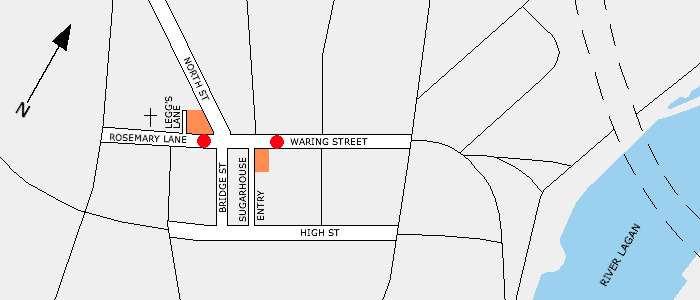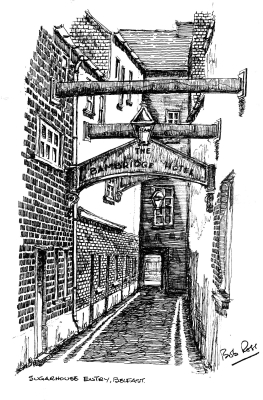Old Sugar House (no.3), established before 1704
<1755-60 LEGG, Benjamin
1760-93 STEWARTS, THOMSON & Co
1793-99 JORDAN Francis & Co
1799-1808 KILBEE James & Co

Old Sugar House (no.3), established before 1704
<1755-60 LEGG, Benjamin
1760-93 STEWARTS, THOMSON & Co
1793-99 JORDAN Francis & Co
1799-1808 KILBEE James & Co

New Sugar House (no.8)
<1678-83 McCARTNEY Black George
1683> McCARTNEY Arthur & Chichester
Rebuilt 1704
1792> MONTGOMERY Hugh, BREW, BOYLE John & TENNANT William
<1805 MONTGOMERY, TENNENT & MAXWELL & Co
1806-8 MONTGOMERY, TENNENT & Co

CLICK the ![]() for sugar houses in that street.
for sugar houses in that street.
(For local directory of sugar houses, click here.) (For UK directory of sugar houses, click here.)

|
|
The length of this map represents 0.6ml / 0.9km. |
**************************************

There is evidence of two sugar refining premises in Belfast, both established in the second half of the 1600s, both still working in 1808, but both out of business by 1811. Black George McCartney ran the Waring Street sugarhouse up to his death in 1683. In 1678 he had leased adjacent land called Wilkins tenement in order to extend the sugarhouse. His sons Arthur & Chichester McCartney inherited the premises.
In 1805 the directories show that Montgomery and Tennent were still refining there with Maxwell as partner, though only Montgomery & Tennent 1806-8. Although dating from before 1704, the Old Sugar House, as it seems it was always known as, in Rosemary Lane, was clearly defined in a lease of 1755. The Donegall Estate leased to Benjamin Legg a plot of ground extending along the west side of North St for 108 feet and bounded on the south side by Rosemary Lane. Specifically mentioned are house, sugarhouses, warehouses and other houses. Legg's Lane ran next to the sugarhouse from Rosemary Lane. Legg died in 1760 and his obituary stated that it was chiefly owing to his skill and activity that the refining of sugar was brought to such perfection in Belfast. Those prosperous times were brought to a halt in the first decade of the 1800s, for although the Belfast industry was keeping that part of Ireland (there were also refineries in Dublin and Cork) self-sufficient in refined sugar, the much acclaimed Acts granting free trade with the American Colonies were soon countered and completely defeated by an arrangement of duties and bounties favouring mainland Britain's refining industry. Sources ... [My thanks to Steve Aldridge for his assistance and interest in this research.]
|
|
|
|